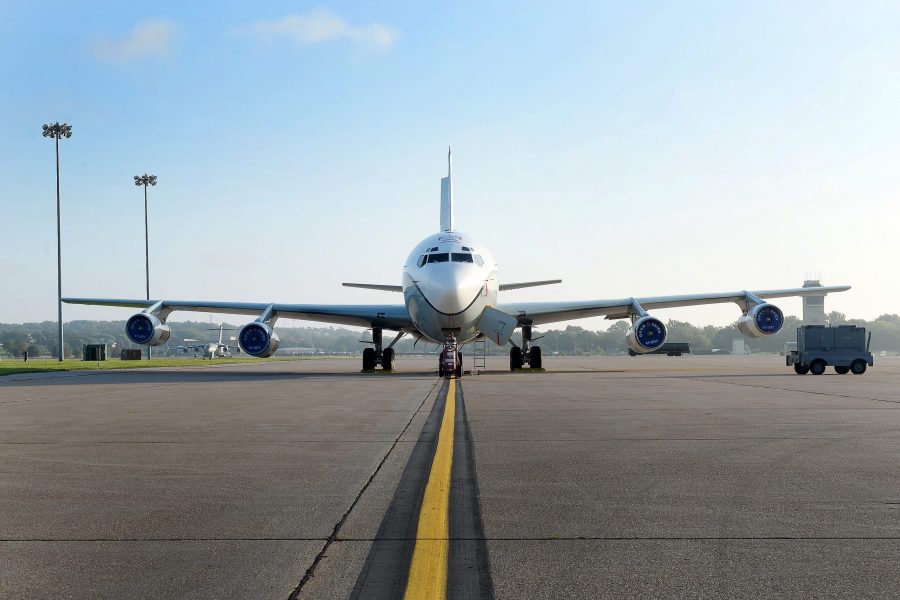The United States is now officially out of the Open Skies Treaty, but questions remain about the road ahead.
The Trump administration announced in May it would leave the pact in late 2020. The treaty, which allows nearly three dozen signatory countries to inspect others’ military installations from above, entered into force in 2002, but U.S. officials have raised complaints about Russia’s conduct and argued that satellite imagery is a better option.
“Six months having elapsed, the U.S. withdrawal took effect on Nov. 22, 2020, and the United States is no longer a state party to the Treaty on Open Skies,” State Department Deputy Spokesperson Cale Brown said.
The Air Force has used a pair of six-decade-old OC-135B jets equipped with wet-film cameras for those flights, but canceled plans to replace the planes with newer airframes amid its withdrawal. That follows another modernization effort to install digital cameras on the fleet.
Many details of how the U.S. military will wind down its participation are still murky. The Wall Street Journal reported Nov. 22 the government has started the process of offering the jets up to other countries.
“We’ve started liquidating the equipment,” a U.S. official told WSJ. “Other countries can come purchase or just take the airframes. They are really old and cost-prohibitive for us to maintain. We don’t have a use for them anymore.”
Steffan Watkins, a Canada-based expert on Open Skies Treaty implementation, noted that the treaty’s other parties are going digital and would likely run into the same modernization issues the Air Force has faced. Germany plans to certify its new digital sensor as the first infrared technology used for the Open Skies mission, while Canada and Italy are putting a digital electro-optical pod under the wing of the C-130 Hercules plane.
“If anyone were to want to buy the old OC-135s, and I can’t imagine anyone would, they’d really need the digital electro-optical sensors the American taxpayer just dropped between $30-42M dollars on,” he said in an email.
Federal officials are largely keeping mum on the process of offloading the jets, what will happen to the Airmen who fly and maintain them, as well as the pictures collected, and if there is work underway to find an alternative to the plane-based intelligence-gathering.
A spokesperson for the 55th Wing at Offutt Air Force Base, Neb., which manages the aircraft and the 45th Reconnaissance Squadron, referred questions to the Office of the Secretary of Defense. An OSD spokesperson referred questions to U.S. Strategic Command at Offutt. A STRATCOM spokesperson referred questions to the State Department, which in turn directed queries back to the Pentagon. The Air Force declined to comment on the record.
“We don’t know how this is going to go,” 45th Reconnaissance Squadron commander Lt. Col. Andrew Maus told the Omaha World-Herald. “We have our duty to train the crews and maintain the aircraft. We’re doing that.”
Watkins suggested the Open Skies crews could work on Offutt’s RC-135 fleet instead, which handles niche reconnaissance missions like analyzing electromagnetic signals and ballistic missile launches. That small group of aging planes is often a target for retirement as well.
Some analysts believe President-elect Joe Biden’s administration will try to rejoin the treaty along with other arms-control measures, while others say the information gleaned from the flights is more important to other signatories than it is to the U.S.
“Were Washington to re-sign the treaty, it then would have to resubmit it to the Senate for consent to ratification,” Steven Pifer, a senior foreign policy fellow at the Brookings Institution, wrote Nov. 19. “However, with at best 50 Democratic senators, … consent to ratify would still need 17 Republican votes. It is difficult to see that many Republicans consenting to ratify a treaty from which a Republican administration has just withdrawn.”
Pifer also suggested the U.S. could pursue an executive agreement to rejoin the treaty that could earn the votes of simple majorities in the House and Senate, and the approval of the other 33 Open Skies signatories.
“The new administration should make clear its intention to rejoin the treaty and put some clever lawyers to work figuring out a way to make that happen,” he argued.


